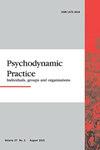谁在社区实践中寻求心理动力疗法?在德国心理治疗报销申请的大样本中检查了患者特征
IF 0.4
Q4 PSYCHOLOGY, CLINICAL
引用次数: 2
摘要
本研究考察了使用门诊心理动力学心理治疗的患者的人口学特征,并将其与普通人群进行了比较。第二个目的是探索使用者的临床和传记特征。我们从德国社区实践中983例心理动力学心理治疗报销申请的随机样本中提取数据。这些应用程序包含为健康保险公司提供的信息,但也包含为专家审稿人提供的额外书面报告。用于比较的人口普查数据来自德国联邦统计局。男性、老年人和移民的代表性不足,而失业者的代表性高于一般人口。三分之一的报告描述了患者遭受身体和/或性暴力的经历。26%的报告提到父母已经分居,其中三分之一的患者当时不到5岁。据报道,五分之一的患者有自杀念头。据报道,约5%的人有自残行为,14%的人对他人有暴力行为。有人提到,9%的病人摄入了危险量的酒精。最常见的诊断组是情感性障碍,其次是神经性障碍,而只有少数人被诊断为物质使用或精神障碍。总之,在德国,男性、移民、老年人以及药物滥用和精神病患者在门诊心理治疗中的比例可能不足,这表明尽管费用普遍覆盖,但获得精神卫生保健的机会不平等。门诊心理动力学心理治疗的患者往往表现出严重的临床问题。本文章由计算机程序翻译,如有差异,请以英文原文为准。
Who seeks psychodynamic psychotherapy in community-based practices? Patient characteristics examined in a large sample of applications for reimbursement of psychotherapy in Germany
This study examined the demographic characteristics of patients using outpatient psychodynamic psychotherapy and compared them to the general population. A second aim was to explore clinical and biographical features of the users. We extracted data from a random sample of 983 applications for reimbursement of psychodynamic psychotherapy in community-based practices in Germany. These applications contain information for the health insurer but also additional written reports for an expert reviewer. Census data for comparison were obtained from the Federal Statistical Office of Germany. Men, older people, and migrants were underrepresented, while the unemployed were overrepresented compared to the general population. A third of the reports described a patient’s experience of physical and/or sexual violence. Twenty-six percent of the reports mentioned that the parents had separated, and a third of these patients were younger than 5 years at that time. Suicidal ideation was reported for a fifth of the patients. About 5% were reported to present with self-harming behaviour and 14% with violence towards others. It was mentioned that the patients were consuming dangerous amounts of alcohol in 9%. The most frequent diagnosis group was affective disorders, followed by neurotic disorders, whereas only few had a substance use diagnosis or a psychotic disorder. In summary, men, migrants, older people, and patients with substance abuse and psychotic disorders are likely underrepresented in outpatient psychotherapy in Germany, indicating unequal access to mental health care despite the universal coverage of its costs. Patients in outpatient psychodynamic psychotherapy often present with severe clinical problems.
求助全文
通过发布文献求助,成功后即可免费获取论文全文。
去求助
来源期刊

Psychodynamic Practice
PSYCHOLOGY, PSYCHOANALYSIS-
CiteScore
0.90
自引率
0.00%
发文量
41
期刊介绍:
Psychodynamic Practice is a journal of counselling, psychotherapy and consultancy and it is written for professionals in all fields who use psychodynamic thinking in their work. The journal explores the relevance of psychodynamic ideas to different occupational settings. It emphasizes setting and application as well as theory and technique and focuses on four broad areas: •Clinical practice •The understanding of group and organisational processes •The use of psychodynamic ideas and methods in different occupational settings (for example, education and training, health care, social work, pastoral care, management and consultancy) •The understanding of social, political and cultural issues
 求助内容:
求助内容: 应助结果提醒方式:
应助结果提醒方式:


